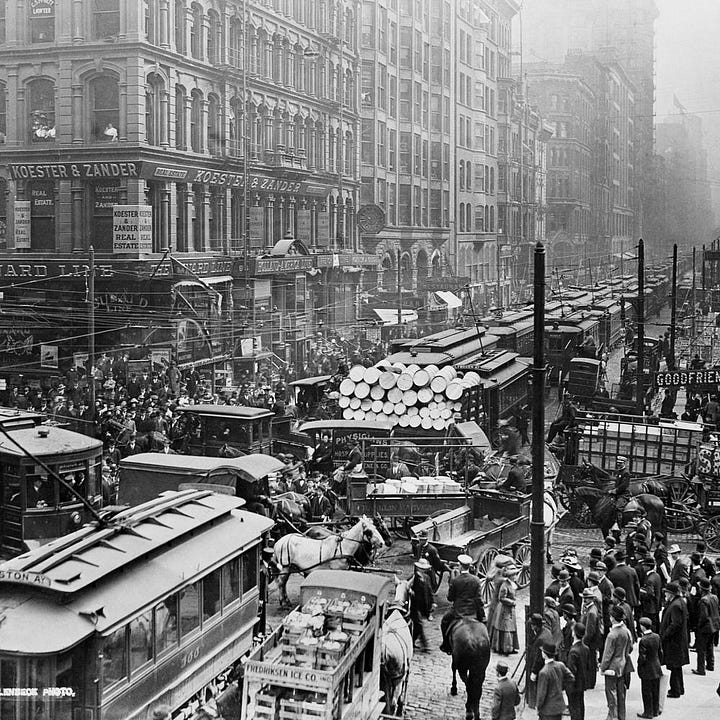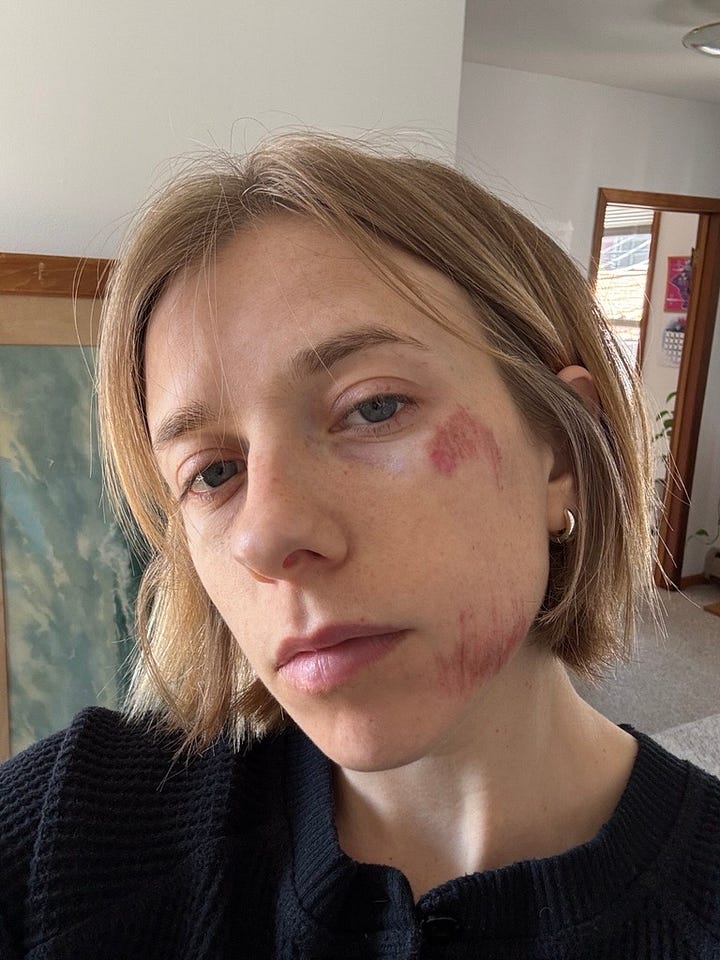Trusting Traffic
Or trying to
Last week, I was knocked off my bike by a truck turning right into an alley— face planting into pavement— still unsure how a large truck hit me, and only my face and hand are scathed. Maybe I blacked out when it hit me, maybe an angel caught me, then dropped me on the pavement, so I could look hard and be helpless, for a little bit.
Beyond the physical impact, the accident pushed me out of an illusion of trust I realized I was operating within— the trust that allows me, and all bikers, to move confidently through the city’s streets. Biking for me was a clarity of movement, a confidence, and a mode of transit to get just about everywhere I go on a regular basis. I felt powerful on the bike, unstoppable, and excellent, you know, riding through a summer night with the breeze in my hair, billowing my clothes.
But last Friday, this illusion of my own power and the invisible safety it provided me was shattered. And in its absence, I became aware of how much this trust had shaped the way I move. Philosopher Anne Baier writes that “We come to realize what trust involves retrospectively and posthumously, once our vulnerability is brought home to us by actual wounds.” Why do we build this trust? And how do we restore it once it’s broken?
City streets are governed not only by laws but by a web of mutual expectations. Urban theorist Kevin Lynch calls this “legibility”: the clarity with which a city’s structure allows people to understand and navigate it. But beneath that legibility lies an even more ephemeral notion: trust. Trust is a kind of necessary vulnerability, one that holds society together through continuous acts of implicit faith. On any given street, we rely on these invisible threads to stay woven— trusting that a car will stop at a red light, that a pedestrian won’t dart into the road, that a cyclist will stay in their lane. These assumptions aren’t just legal obligations; they’re ethical and behavioral implications shaped by design.
After the accident, I got curious about the assumptions we have about city streets and how they’ve trained us into rhythms of movement and trust. Back in the 18th and 19th centuries, the street was a chaotic commons: pedestrians, horses, carts, livestock all moving along their own desired paths. But with the rise of the streetcar, and then more intensely, the automobile in the early 20th century, a new order was imposed to prioritize vehicular flow through the city: highways, traffic lights, curbs, lanes. The automobile industry lobbied for these changes in order to center the car in urban life, even inventing the jaywalking law to shift moral responsibility away from drivers. Streets were not for people; they were for cars. And bikes, of course, were an afterthought.


Only in the last few decades have bike lanes been incorporated into urban infrastructure. Chicago is still in the process of building protected bike lanes along Milwaukee Avenue, which sees up to 3,000 riders a day. But on Wabansia— the street where I was hit—there is no bike lane. It’s a wide, two-way street with parked cars on either side and speed bumps. I was struck right after one of those bumps by a truck making a turn without signaling. There was no curb separation or visual cue to alert the driver that a cyclist might be behind him. The street’s infrastructure did nothing to protect me.
To avoid incidents like this, cities should build streetscapes that prioritize bikes and pedestrians over cars. Tucked away in idyllic little Bucktown, don’t we want to commune with one another on a personal level? Not fear for every car that barrels through without a blinker? Pedestrians and bikers are not obstacles to traffic flow; they are full participants in the shared space of the street.
Now that I am mostly better— wounds are sealing and bruises receding into the yellow tones of skin— I wonder when I will feel less afraid. My trust in vehicles is probably the most damaged of all, beyond my helmet and the bike. Trust, Baier says, is a morally loaded form of vulnerability on which most of our social world is built. When it is violated, paranoia and fear take root. Yet a life without trust is unlivable and almost impossible— fear leaves you stuck, alienated in the self, unable to connect or make space for new things to grow. Baier warns against a world governed by “antitrust”— the refusal to trust at all, which for me would mean abandoning biking altogether, or at least only doing it in constant fear.
I haven’t gotten back on my bike yet, but when the new helmet comes, I’ll be ready. I want to feel free. To have only one accident among the thousands of uneventful rides in my life is statistically so slim, but one rug pulled and you fall down regardless. To trust cars again might be foolish, but to never trust them again would make city life unbearable. There must be an in between— a wariness, I suppose, more caution, knowing the risks.
If trust is the softness below the surface of infrastructure, I’ll first need something for it to nestle under— like protected bike lanes and more signage, perhaps, to make drivers pay attention. Why don’t we start there?
And if the driver who hit me is somehow reading this, you owe me $200, please!



How scary!!! I’m glad you are mostly alright and hope you have a complete and speedy recovery ❤️❤️❤️❤️❤️🌷
Wow! Glad you weren't seriously hurt! Rebuilding trust can be difficult after something like that, so I wish you Godspeed on getting back on that "horse."